You need proper chain end finishing to prevent serious safety hazards and chain failure. Unfinished wire ends create razor-sharp edges that can cut skin and snag clothing during operation, while also forming stress concentration points that cause premature breakage. Properly finished ends with rounded, smooth surfaces eliminate these risks, reduce friction for smoother movement, and distribute loads evenly across links. Professional techniques and regular maintenance will transform dangerous chain ends into safe, high-performing components.
Safety Considerations for Chain End Maintenance
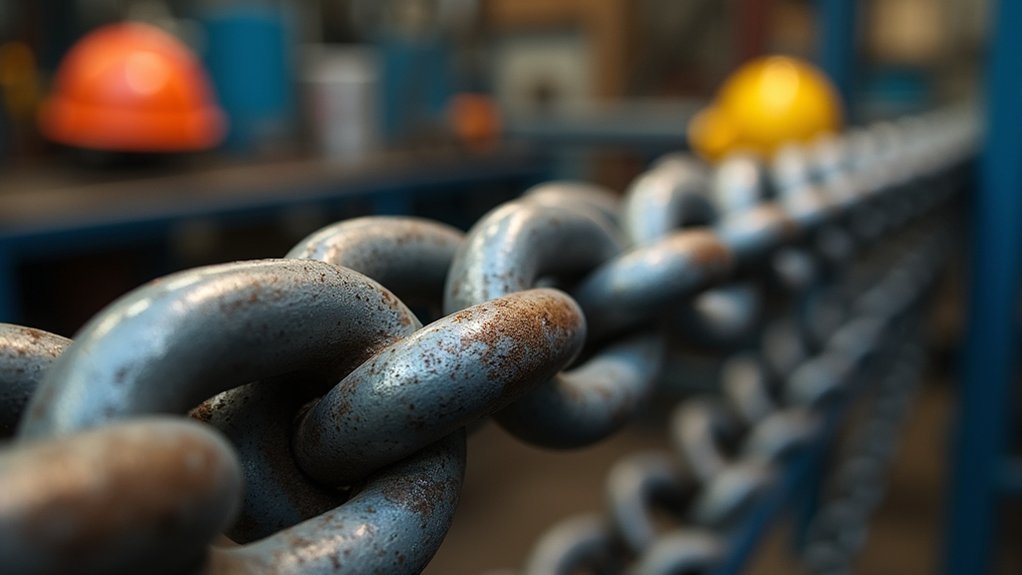
When handling chains with improperly finished ends, you’re exposing yourself to significant safety risks that can easily be prevented through proper maintenance. Sharp, unfinished edges can cut your skin or snag on clothing, creating dangerous situations during operation. A properly finished chain eliminates these hazards by providing smooth, rounded ends that won’t catch or injure.
You’ll need to regularly inspect your chains for signs of wear and tear at the endpoints. Poor finishing accelerates deterioration, making chains more likely to break under stress. This is especially critical in safety applications where failure isn’t an option.
Through consistent maintenance and proper finishing techniques like balling wire ends or adding protective caps, you’ll extend chain life while ensuring safe handling for everyone involved.
Preventing Injuries From Sharp Chain Edges
You’ll encounter serious safety risks when chain ends aren’t properly finished, as sharp edges can slice through skin and snag clothing during routine handling.
Implementing proper balling techniques transforms dangerous wire ends into smooth, rounded surfaces that won’t cut you during installation or maintenance work.
You can achieve this essential safety protection through careful smoothing methods that eliminate all protruding edges and create a user-friendly chain surface.
Sharp Edge Hazards
Although chain functionality often takes priority during manufacturing, sharp edges on unfinished chain ends pose serious safety risks that can result in painful cuts and injuries during handling, assembly, or maintenance work.
These sharp edge hazards increase greatly when chains lack proper end finishing, as unpolished or rough edges can easily slice through skin upon contact.
You’ll face the highest risk during assembly and maintenance tasks when you’re directly handling the chains. Without proper end finishing, even brief contact with unfinished ends can cause deep cuts.
User safety depends heavily on implementing finishing techniques like torching wire ends into balls or polishing rough edges smooth. Regular inspections help you identify potential hazards before accidents occur, while protective coatings provide additional safety barriers against sharp surfaces.
Proper Balling Techniques
Balling techniques represent the most effective method for eliminating sharp chain edges that threaten user safety. You’ll heat wire ends straight up and down using a torch, creating smooth, rounded edges that won’t cut or scrape your skin. This process transforms dangerous sharp edges into comfortable, safe surfaces.
| Step | Tool | Safety Benefit |
|---|---|---|
| Heat wire ends | Torch | Creates rounded edges |
| Use heat sink | Metal block | Protects surrounding links |
| Inspect finish | Visual check | Confirms smooth surface |
You can also solder small jump rings to chain ends for additional protection. Remember to utilize a heat sink during balling techniques to prevent damage to surrounding links. Regular inspection guarantees your safety measures remain effective over time.
Safety Through Smoothing
When working with chains, sharp edges pose serious safety risks that can result in painful cuts, snags, and injuries during handling or wear. Smoothing sharp chain edges through soldering or grinding techniques effectively eliminates these hazards, creating safer contact surfaces for users.
You’ll find that rough, unfinished chain ends don’t just threaten user safety—they can also snag clothing, damage equipment, or cause unexpected accidents during operation.
Regular maintenance of your chains should include inspecting and refinishing any rough spots that develop over time.
Reducing Wear and Tear Through Proper Finishing
Since chains endure constant stress during use, proper end finishing becomes your first line of defense against premature wear and failure.
Proper chain end finishing serves as your primary protection against early deterioration and costly equipment failure.
When you apply proper finishing techniques to chain ends, you’re creating protective barriers that greatly reduce wear and tear over time.
Soldering jump rings or end caps to your chain ends provides secure connections that prevent stress concentration points where failure typically begins.
You’ll also want to ball up wire ends with a torch, creating smooth surfaces that eliminate sharp edges causing friction and metal fatigue.
Clean finishes minimize exposed metal surfaces, preventing rust and corrosion that weaken chain integrity.
Regular maintenance checks of your finished ends help identify potential problems before they escalate, extending your chain’s operational lifespan considerably.
Enhancing Chain Movement and Link Performance
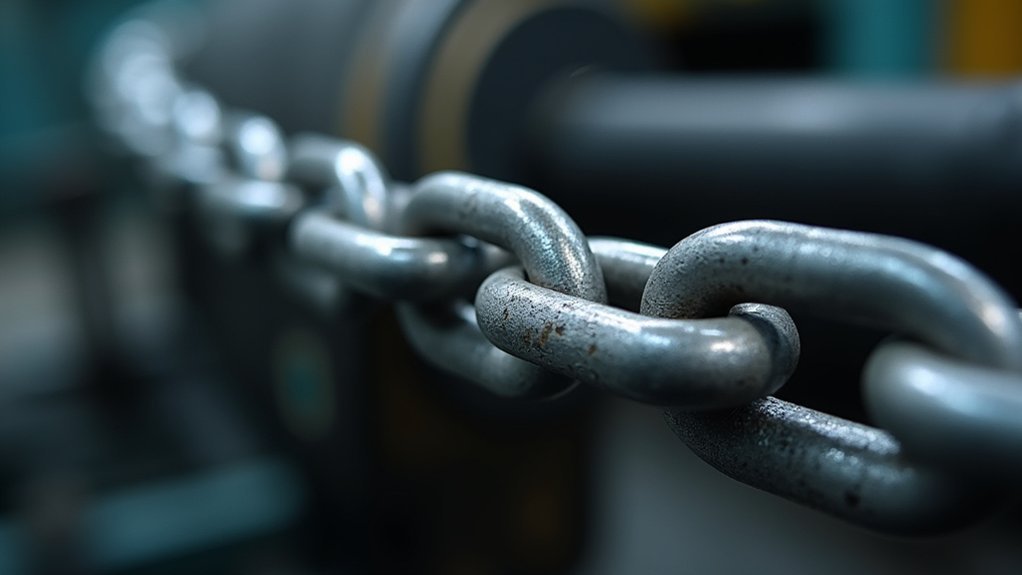
While reducing wear protects your chain’s structure, optimizing end finishing techniques directly enhances how smoothly your chain moves and performs during operation.
When you properly smooth and seal rough edges, you’ll eliminate friction points that cause jerky movement and binding between links.
Key benefits of proper end finishing for enhanced performance:
- Reduced friction – Smoothed edges allow links to move freely without catching or grinding against each other
- Prevention of snagging – Secure finishing eliminates sharp edges that can bind during operation
- Stress reduction – Well-finished ends distribute loads evenly, minimizing strain on individual links
- Corrosion protection – Galvanizing or plating preserves smooth surfaces and prevents rust buildup
This improved link performance translates directly into enhanced durability and operational reliability for your chain system.
Minimizing Friction for Optimal Efficiency
Enhanced link performance sets the foundation for achieving maximum efficiency in your chain system. Minimizing friction at chain ends directly impacts your overall operational effectiveness. When you maintain properly finished surfaces, you’ll reduce wear and extend your chain’s lifespan considerably.
Rough or improperly finished chain ends create increased resistance, causing energy loss during operation. You’ll notice improved lubrication effectiveness when surfaces are properly finished, promoting better penetration and reducing friction-related heat generation.
| Finish Quality | Friction Level | Efficiency Gain |
|---|---|---|
| Poor | High | 0% |
| Average | Medium | 10% |
| Excellent | Low | 20% |
| Premium | Minimal | 25% |
Well-finished chain ends help maintain proper tension, preventing slippage and ensuring ideal efficiency in power transfer throughout your system.
Rust and Corrosion Prevention Strategies
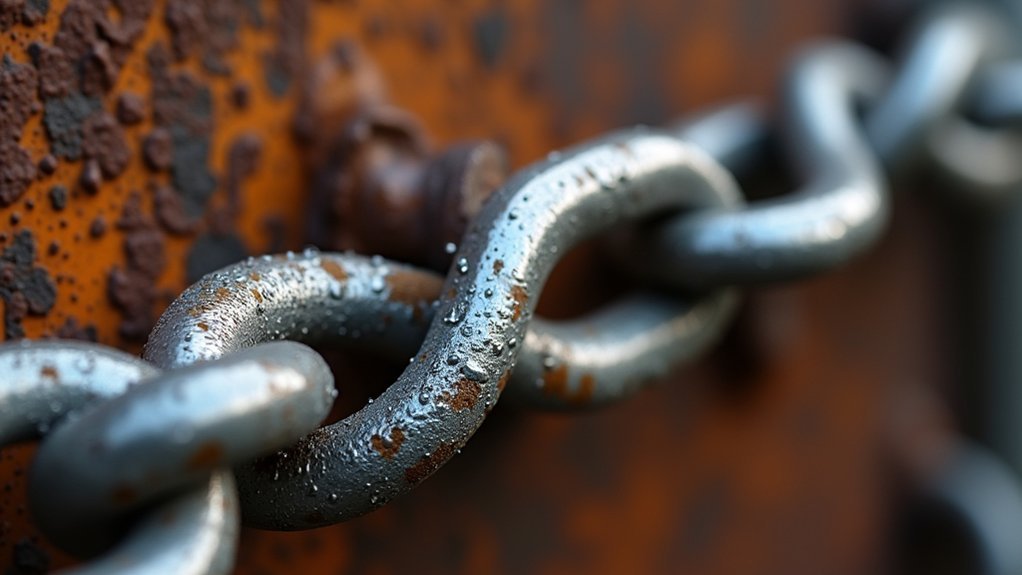
Although your chain’s performance depends on proper finishing, protecting it from rust and corrosion guarantees long-term reliability and maintains that peak efficiency you’ve worked to achieve.
Effective rust prevention requires a multi-layered approach that addresses both immediate protection and long-term maintenance strategies:
- Apply protective coating regularly – Use WD40 or similar products to create moisture barriers that prevent corrosion from starting on chain surfaces.
- Choose gold-finished chains – These offer superior rust resistance in wet conditions compared to natural finish alternatives.
- Store chains properly – Keep them in dry environments away from moisture exposure to greatly extend their operational lifespan.
- Monitor condition frequently – Inspect chains regularly, especially during cooler months, to identify early rust signs before they compromise functionality.
Extending Chain Lifespan Through Quality Finishing
Quality finishing techniques directly impact how long your chains will serve you in the field.
When you master proper soldering techniques, you’re creating secure connections that won’t fail under stress, while sealed ends prevent moisture from penetrating vulnerable link joints.
Regular maintenance of these finished ends helps you catch early signs of rust before it spreads, saving you from costly chain replacements down the road.
Proper Soldering Techniques
When you solder chain connections properly, you’re investing in jewelry that will withstand daily wear for years to come. Proper soldering techniques greatly improve the durability of chain jewelry by creating permanent bonds that won’t fail under stress.
Essential Soldering Steps for Maximum Chain Durability:
- Clean all surfaces with 800 grit sandpaper and apply flux before heating to guarantee strong, reliable bonds.
- Use a heat sink during the process to protect delicate chain links from heat damage while working.
- Solder jump rings closed near clasps to create secure connections that minimize wear and reduce breakage risk.
- Ball up wire ends with your torch for smooth finishes that enhance comfort and prevent skin irritation.
These techniques replace weak mechanical connections with permanent joints that greatly extend your chain’s lifespan.
Maintenance Prevents Rust
Three critical maintenance practices will protect your chain from rust and dramatically extend its working life.
First, establish a regular lubrication schedule to create a protective barrier against moisture.
Second, conduct timely inspections to identify early signs of wear before rust takes hold.
Third, clean your chains thoroughly after exposure to wet conditions.
When you follow these maintenance protocols consistently, your chains look better and perform reliably for years longer than neglected alternatives.
You’ll notice that well-maintained chains resist operational issues that plague rusty equipment.
If galvanizing begins wearing off, you can switch chain ends to utilize less worn sections, maximizing your investment.
Professional Soldering Techniques for Chain Ends
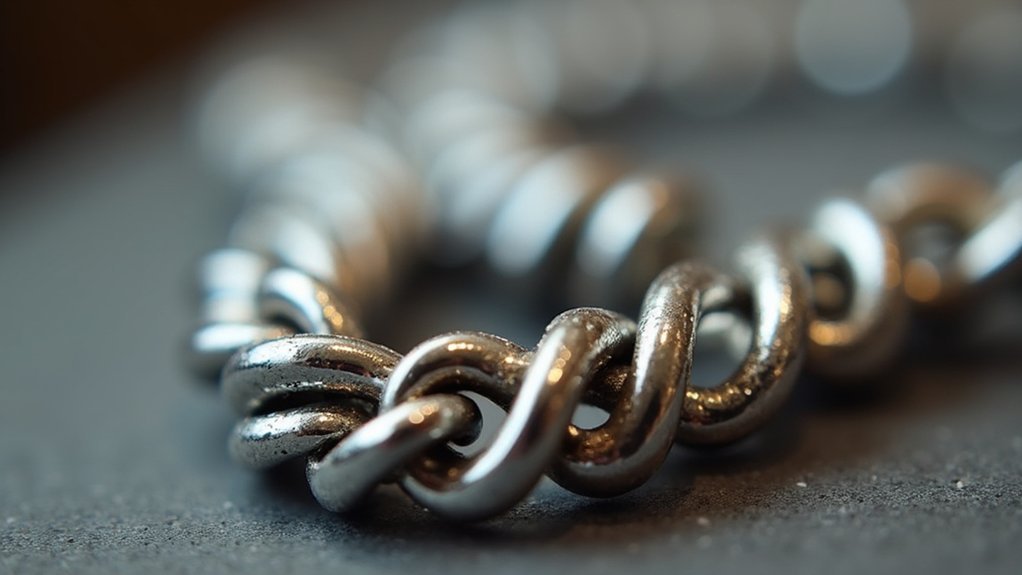
Securing chain ends through professional soldering transforms a fragile connection into a permanent, reliable bond that withstands daily wear and stress.
Professional soldering elevates jewelry chains from vulnerable weak points to enduring connections built for lifetime durability.
Proper end finishing requires specific techniques when soldering jump rings to achieve secure connections that won’t fail under pressure.
Follow these essential steps for professional results:
- Surface preparation – Clean all surfaces with 800 grit sandpaper to enhance solder flow and create stronger bonds.
- Flux application – Apply flux with silver solder chips for smooth, even solder distribution across the joint.
- Heat protection – Use heat sinks to shield delicate chain materials from excessive temperature damage.
- Stabilization – Employ third hand tools to hold jump rings steady, ensuring precise control during the soldering process.
These techniques guarantee durable, professional-quality chain end connections.
Heat Sink Applications in Delicate Chain Work
Since delicate chain links can warp or melt under direct heat exposure, you’ll need heat sinks to protect vulnerable areas during soldering operations.
Position copper or aluminum heat sinks directly adjacent to your work area on the linked chain to absorb and redirect excess thermal energy away from sensitive components.
You’ll achieve the best protection by placing the heat sink as close as possible to the soldering point without interfering with your torch access. This proximity maximizes heat absorption while maintaining clear workspace visibility.
The controlled heating environment created by proper heat sink placement improves solder flow characteristics, resulting in stronger joints.
Choose copper heat sinks for maximum thermal conductivity, or aluminum alternatives for lighter applications.
Your delicate chain work will maintain structural integrity throughout the soldering process.
End Cap Installation Methods and Benefits
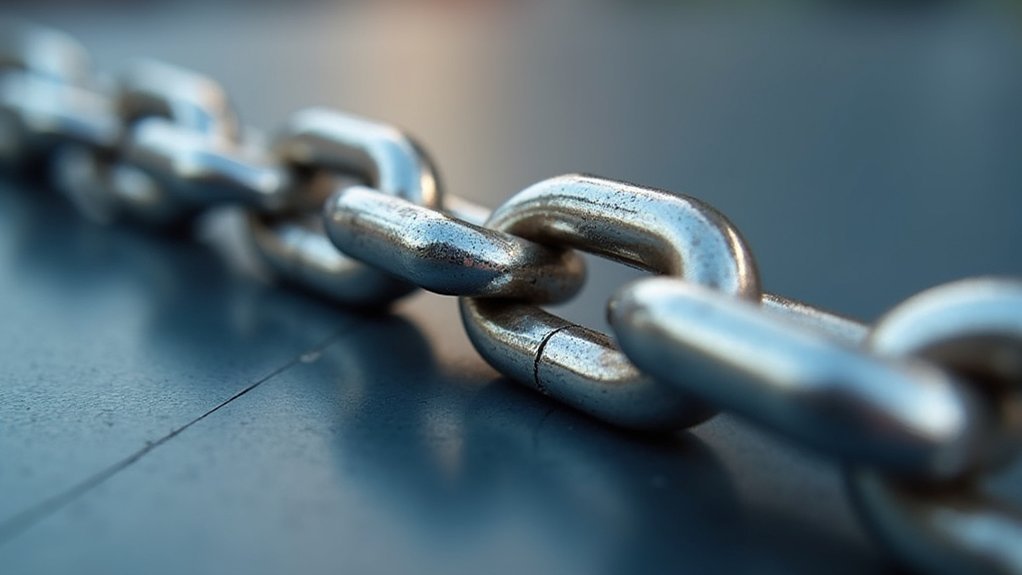
Installing end caps transforms your chain jewelry from loose, vulnerable links into a secure, professional piece that’ll withstand daily wear.
These essential components prevent links from separating while creating opportunities for personalized decorative touches.
Follow these critical steps for successful end cap installation:
- Clean thoroughly – Sand both the chain link and end tab to remove oxidation and promote superior solder adhesion.
- Position strategically – Place the chain link half on, half off the end tab to guarantee strong bonding while preserving flexibility.
- Use stabilization tools – Employ a third hand tool during soldering to prevent movement and enable precise heat application.
- Apply proper technique – Heat evenly to create seamless joints without compromising the chain’s structural integrity.
Properly installed end caps enhance durability and aesthetic appeal simultaneously.
Tools and Materials for Effective Chain Finishing
Achieving professional chain finishing results depends entirely on having the right tools and materials at your disposal.
Professional chain finishing success hinges on selecting the proper tools and quality materials for each specific jewelry-making task.
You’ll need jewelry pliers for precise manipulation and soldering equipment to create secure connections between chains and fittings. End caps and jump rings serve as your primary finishing materials, providing both stability and a polished appearance when properly attached.
Before soldering, you’ll want 800-grit sandpaper to clean surfaces, which enhances the bond between your chain and end fittings.
A third-hand tool becomes invaluable during the finishing process, offering the stability and control necessary for precise soldering work.
For wire ends, the balling method creates smooth, comfortable edges that greatly improve wearability and overall quality of your finished chain jewelry pieces.
Frequently Asked Questions
What Is the Thing on the End of a Chain Called?
You’ll find the component at a chain’s end called a “chain end” or “end fitting.” It’s designed to attach your chain to other elements or secure it properly in place.
How to Fix the End of a Chain?
You can fix your chain’s end using jump rings for quick repairs or soldering for permanent solutions. Clean surfaces with sandpaper, apply flux, then solder. Use end caps when jump rings won’t fit properly.
How to Finish Ends of Snake Chain?
You’ll need to sand the chain ends clean, then solder or crimp end caps onto them. Heat evenly when soldering and apply solder to the cap’s seam for a strong, secure bond.
How Do You Finish a Chain Necklace?
You’ll attach jump rings to secure chain ends and clasps, ensuring they’re properly twisted closed. For stronger connections, solder the jump rings or use end caps, especially with delicate chains.
In Summary
You’ll protect yourself and extend your chain’s lifespan by investing time in proper end finishing. Don’t overlook sharp edges that can cause injuries or premature wear. Use professional soldering techniques with heat sinks when working on delicate pieces, and consider end caps for added protection. You’re not just improving safety—you’re maximizing efficiency by reducing friction and enhancing overall performance. The right tools and materials make all the difference in achieving quality results.

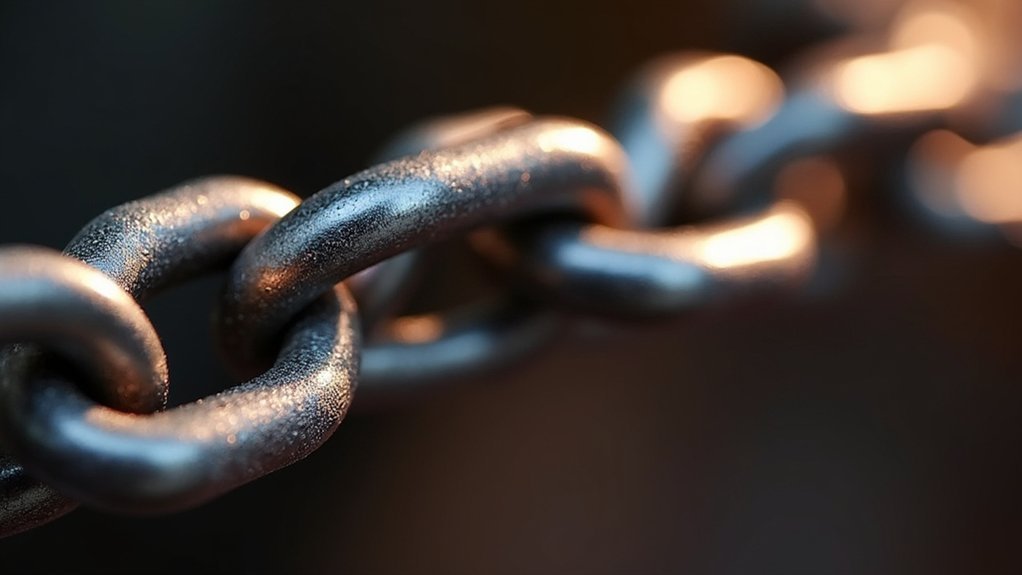



Leave a Reply